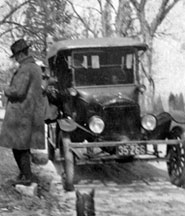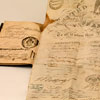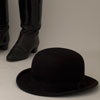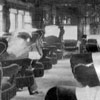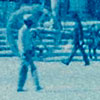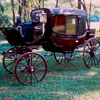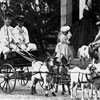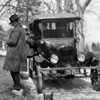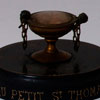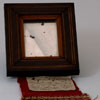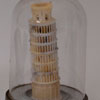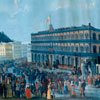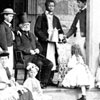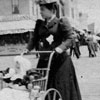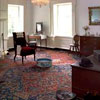|
- Catherine Holden,
Park Ranger, Fort McHenry/Hampton National Historic Site, Teacher at Franklin High School
- 8th-10th Grades (can be modified for high school and middle school students)
- 6 lessons
[Back to top]
|
- Hampton National Historic Site, Towson, Maryland
-
This cross-curricula unit examines travel in the 19th century through the experiences of the people who lived at Hampton Mansion. Hampton Mansion provides a unique insight into 19th century travel since its owners, the Ridgely’s, traveled locally, nationally, and internationally. Therefore, through the family’s experiences, students can acquire a wide range of information about international relations, political systems, modes of transportation, and individual curiosity. Through the utilization of six fifty minute lessons, students will be able to explore the economic, political, technological, and cultural developments of the 19th century in the United States and the world by examining objects from the time period. These lessons will supply students with a historical understanding of global events as well as allow students to employ their language arts skill in the classroom.
- Lesson One – U.S. Passport: In this lesson, students compare and contrast a historic passport with a contemporary passport in order to identify the role of the government in international travel. This lesson allows students to use their language arts skills as they create their own school passports. In the extension activities, the students can also perform research on regions seen as unadvisable for travel by the State Department or write a local trip advisory for their local community.
- Lesson Two – Methods of Travel: In this lesson, students identify the various modes of transportation utilized in the 19th century to enable people to move throughout the nation and the world. As students examine historical objects as well as complete mathematical equations on the speed of travel, the students will acquire a better understanding of distance and time. In the extension activities, student can create brochures and advertisements in order to hone their creative writing skills.
- Lesson Three – Grand Tour: In this lesson, students will read excerpts of Eliza “Didy” Ridgely’s journal and learn about the experiences of taking a grand tour in Europe. In addition, this lesson will allow students identify major European events witnessed by Americans in 1848 as well as the means by which American desired to remember these experiences through souvenirs. In the extension activities, students are encouraged to keep their own journal in order to determine what he/she sees as important within a given day or create their own itinerary for a modern Grand Tour.
- Lesson Four – Instituting a King: In this lesson, students compare and contrast the implications of the coronation of a king in the 19th century verses the inauguration of a President in the 21st century. In the extension activities, the students are encourage to use their creative writing skills to compose a reflective journal of what it was like before, during, and after the event or to create a newscast from the event.
- Lesson Five – Seaside Travel: In this lesson, students will identify methods of relaxation used by wealthy Americans in the nineteenth century. After examining photographs of the Ridgely’s on vacation, the students will create postcards describing and illustrating the experiences at the seaside resorts. In the extension activities, students will be encouraged to design their own dream vacations.
- Lesson Six – Traveling Trunk: In this culminating lesson, the students will construct trunks of objects acquired during the 19th century by the Americans as they traveled nationally and internationally. In this lesson, the students will describe and explain the significance of each object as well as create stickers to decorate their trunks.
The lessons in this unit can be used individually to gain a better understand of the modes of transportation, the role of government, and the experiences and excitement of vacationing in America and abroad. In addition, all of the lessons can be used together to gain a complete understanding of the various travel experiences of the Americans during the 19th century through the experiences of the Ridgely family.
-
- How do objects represent our memories?
- How did the methods of travel change throughout the 19th century?
- How did travel impact the American perspective on government, culture, class, and foreign affairs?
[Back to top]
|
| MUSEUM OBJECT [photos of objects in the Carl Sandburg Home NHS museum collections] |
SIMILAR OBJECTS [local items similar to museum objects] & OTHER MATERIALS |
Length of time |
|
45-50 minutes |
|
- Hoppity Ball
- One Roller Skate
- Scooter
|
45-50 minutes |
|
- Contemporary Souvenirs like Pencils, Key Chains, Pins, Snow Globes
|
45-50 minutes |
|
- Images of the Presidential Inaugurations
- Regalia from political campaigns
|
45-50 minutes |
|
- Contemporary images of beach resorts
- Mickey Mouse Ears, Fisherman’s Hat
- Placard of the Photographs
- ½ Sheets of Paper
- Markers
|
45-50 minutes |
|
- Cardboard Box Wrapped in Solid Paper (i.e. Paper Box, Shoe Box)
- Markers
- Stickers
- Construction Paper
- Classroom Resources
|
90 minutes |
[Back to top]
|
- Understands how the rise of corporations, heavy industry, and mechanized farming transformed the American people
- the causes and consequences of political revolutions in the late 18th and early 19th centuries.
- the transformation of Eurasian societies in an era of global trade and rising European power, 1750-1850.
- patterns of nationalism, state-building, and social reform in Europe and the Americas, 1830-1914
- Students apply a wide range of strategies to comprehend, interpret, evaluate, and appreciate texts. They draw on their prior experience, their interactions with other readers and writers, their knowledge of word meaning and of other texts, their word identification strategies, and their understanding of textual features (e.g., sound-letter correspondence, sentence structure, context, graphics).
- Students adjust their use of spoken, written, and visual language (e.g., conventions, style, vocabulary) to communicate effectively with a variety of audiences and for different purposes.
- Students employ a wide range of strategies as they write and use different writing process elements appropriately to communicate with different audiences for a variety of purposes.
- Students use a variety of technological and information resources (e.g., libraries, databases, computer networks, video) to gather and synthesize information and to create and communicate knowledge.
- Students use spoken, written, and visual language to accomplish their own purposes (e.g., for learning, enjoyment, persuasion, and the exchange of information).
- Students reflect on how artworks differ visually, spatially, temporally, and functionally, and describe how these are related to history and culture.
- Students differentiate among a variety of historical and cultural contexts in terms of characteristics and purposes of works of art.
- As a result of activities in grades 9-12, all students should develop understanding of
- Science as a human endeavor
- Nature of scientific knowledge
- Historical perspectives
- make decisions about units and scales that are appropriate for problem situations involving measurement.
[Back to top]
|
- To critically analyze objects and draw conclusions about life during the 19th century.
- Use analysis to develop a deeper understanding of the impact of travel on the lives of American citizens in the 19th century
- To compare life during the 19th century to students’ lives today.
- To research contemporary places of interest in order to create usable itineraries for travel
- To use language arts skills to create postcards, journal entries, blogs, and brochures as it relates to historic events, contemporary issues, and personal opinions.
[Back to top] |
Throughout the 19th Century, American aristocracy joined the European tradition of going on a Grand Tour of Europe. The Grand Tour of Europe consisted of visiting numerous European regions in order to gain a better understanding of their culture, language, and past. The length of Grand Tour varied from 8 months to eight years (Getty). With improvements in transportation, many Americans found themselves compelled to go to Europe to fulfill their curiosity, increase business ventures, and study at foreign universities (SAGE). For the younger generation, this experience represented the culmination of many years of studying languages, the classics, art, and history making the Italian States of Rome, Naples, and Venice very popular (Getty).
The Hampton saga began with Colonel Charles Ridgely’s (1702-1772) purchase of 1,500 acres in what was considered wilderness north of Baltimore for the production of tobacco. By 1760, he had purchased an additional 10,000 acres elsewhere in the county, set up Northampton Iron Furnace and began trading iron both locally and overseas. When he died in 1771, Captain Charles Ridgely (1733-1790) began to increase the agricultural production of wheat and other grains. During and after the American Revolution, earnings from commercial agriculture, speculation in coal and real estate and, most importantly, the sale of munitions and ironware to the Continental Army enabled the Captain to become even wealthier and these ventures provided him the income to build a grand country house now known as Hampton Mansion. At his death in 1790, Captain Ridgely owned 92 slaves and 24,000 acres.
Captain Ridgely’s primary heir was Charles Carnan Ridgely (1760-1829), a three-term Governor of Maryland, who received half the estate. He continued to increase the family fortune through his activities in banking, canal and railroad building, horse breeding, commerce, iron making, and commercial agriculture. In his 40-year tenure in the mansion, Governor Ridgely acquired many important furnishings, including furniture, silver, paintings, textiles, and books. When Governor Ridgely died in 1829, he owned over 300 slaves at Hampton and his city property. Governor Ridgely’s son, John (1790-1867), inherited the Hampton mansion with his wife Eliza (1803-1867), continued to increase the furnishings and decorative arts and they were strongly influenced by their extensive travels in Europe.
The increase in wealth and status provided the Ridgely family the opportunity to travel nationally and abroad. Throughout the 19th century, members of the family traveled to Europe in at least four documented occasions. In the 1820s, John Ridgely traveled to Italy where he began the family’s collection of European artifacts and paintings. In the 1830s, John and Eliza Ridgely visited Italy, again. From 1846-1848, John Ridgely and Eliza Ridgely traveled throughout Italy, France, Ottoman Empire, and the German States with their children, Eliza “Didy” and Charles, partaking in a Grand Tour of Europe. During this time period, the family members witnessed the Revolution of 1848 in Paris. In 1870s, Charles Ridgely returned to Europe with his wife, Margaretta Howard and their children. They witnessed the devastation of the Franco-Prussian War in Paris and the French countryside. For each of these experiences, the family relied on travel books to guide their experiences. In addition, to travel abroad, the family spent many summers visiting local seaside resorts. Among the places visited include Atlantic City New Jersey, Newport News Virginia, and Watch Hill Rhode Island.
Within Hampton National Historical Site’s collection, guide books published in the 19th century can be located and correspond with the family’s itineraries in Europe. The family had well planned trips and relied on contemporary books such as A Week in Venice: Illustrated Guide, Travels in Europe, and Italy: Handbook for Travelers. These books informed Americans and Europeans of the best methods to travel. As in the case of A Week in Venice, this 186 page book provided American travelers with a historical overview, the weather report as well as a possible itinerary. In the itinerary, the book describes a day by day method by which to the tour the city. For each day the travel book describes the major sites and elaborates on the significant facts and details. The book also recommended prices for the use of public transportation and telegrams. At the end of travel book the publisher supplies the American reader with factual information like the location of churches, banks, hotels, government buildings and consultants. (Note: A Week in Venice can be viewed at Google Books.
|
Baptistery – the building used to perform the Holy Sacrament of Baptism for Catholics.
Coliseum – an amphitheatre built during the Roman Era. Its ruins are located in the center of Rome, Italy.
Congress of Vienna – a meeting in 1815 between the major European nations to restore the “balance of power” and the conservative ideology throughout Europe following the Napoleonic Era.
Dominican Procurator General – the representative of the Dominican order to the pope.
Duomo – Italian for church.
Ferdinand IV – King of the Kingdom of Two Sicilies prior to and after Napoleon’s reign
Frescoes – a painting technique popular during the Renaissance.
Galileo – a scientist from the scientific revolution that supported the heliocentric theory and used a telescope to gather evidence.
German Confederation – prior to 1871, modern day Germany consisted of numerous independence German states.
Golden Palace of Nero—a roman palace built during the first century. Its ruins are located in Rome, Italy.
Grand Tour – a trip taken by the elite in the nineteenth century in which they visit parts of Europe for an extensive period of time.
Holy Sacraments – religious rituals performed by Roman Catholics to obtain grace.
Italian States – prior to 1861, modern day Italy consisted of numerous independent kingdoms.
Jerusalem – a holy city for Christians located in the Middle East.
Latin – the predominant language of the Roman Catholic Church until the 20th century.
Leghorn, Italy – an Italian city located South of Pisa on the coast of the Mediterranean Sea.
Kingdom of Two Sicilies – a kingdom in Italy composed of regions south of Naples and the island of Sicily.
Michelangelo – a Renaissance painter that was commissioned to paint frescoes in the Sistine Chapel by Pope Julius II.
Palais Royal – the royal palace of the king of France in Paris.
Passport – a document provided by a government that allows its citizens to travel outside of their country’s borders.
Pauline Chapel – a church in the Vatican located near the Sistine Chapel.
Pisa – an Italian city.
Pope – Spiritual leader of the Catholic Church.
Sistine Chapel – a 16th century chapel commissioned by Julius II and located in the Vatican. It contains numerous Renaissance masterpieces such as Michelangelo’s The Last Judgment.
Temple of Minerva – a roman temple.
Temple of Venus and Rome – a Roman temple located at the Forum in Rome, Italy.
[Back to top]
|
|
- All activities can be adapted for class length
- Download the images of museum objects and captions for reference
- Download the images, print in color, and laminate, if possible
- Utilize projector technology in order to examine the objects as large and clear as possible as a class
[Back to top] |
- Students will be able to analyze a nineteenth century passport in order to identify the rules and regulations for travel during that time period.
- Students will be able to compare and contrast travel in the nineteenth century with travel today.
For this lesson, you will be relying on an 1846 passport (HAMP 14525) that was issued prior to the two-year trip to Europe taken by the four members of the Ridgely family – John Ridgely, Eliza Ridgely, and their two teenage children, Eliza “Didy” and Charles. The passport is made of paper, cloth, and cardboard. The passport was issued by the U.S. Department of State and various signatures can found on it such as Secretary of State James Buchanan. The inscription reads: “To all to whom these Presents shall come. Greetings. I the Undersigned. Secretary of State of the United States of America hereby request all whom it may concern to permit safely and freely….a Citizen of the United States and in case of need to give him lawful aid…” In addition, diplomatic stamps and inscriptions of various European countries are also on the passport. These included England, France, Italian states, several Mediterranean Islands, the Ottoman Empire (modern-day Turkey), Greece, Austria, the German Confederation, and Belgium. Specific examples include:
- Paris, 30 March 1848 ( Top Left Corner)
- Legation of the United States London (Bottom Left Corner)
- Department of State Camp (Bottom Center)
- At the beginning of the class period, inform the students that this class is responsible for creating a new “hall pass” for the school. As a class, on a chalkboard or overhead projector, the student will identify what must be included on the school pass. As a teacher you may supply them with the following prompts, if needed:
- Where do students travel to in a school?
- How should you identify whom the pass belongs to? What other information about the student should be provided?
- How should the pass verify its accuracy/validation?
- Whose authority is needed to use the pass?
STUDENT SAMPLE
SAMPLE PASS |
Franklin High School Hall Pass
Name: __________________________ Grade: __________ Date: _____________
Location to:
___ Library ___ Cafeteria ___ Homeroom ___ Gym ___ Auditorium
___ Main Office ___ Bathroom ___ Water Fountain ___ Classroom ___ Other
Permission By: _______________________________________________________________
|
- After the students have finished creating the school passport, use the passport to discuss the function of the school administrators and teachers as it relates to the “hall pass/passport”. For example,
- Where do students go to? Where can students NOT travel to? Who determines this?
- Why would you want to include the name and grade of a student on a hall pass? What information may be important to know that we left out?
- Why do you need permission to move around the school?
- What is the “real” function of a hall pass?
- Why are hall passes needed? What is their function? Do they protect students?
- Move the students into small groups. Supply each group with a color copy of the 1846 passport as well as the chart “How to Read an Object”. Since the students have had the opportunity to create a school passport, they should be more adept at analyzing the actual document and completing the chart. Each student should be responsible for taking his or her own notes about the Passport.
- After the students have had approximately 12-15 minutes to assess the passport, as a class, debrief the historic passport. For example:
- What is it called?
- What is or was it used for? Has it been changed or repaired?
- Is it worn? Does is show proof of being used?
- Does it have identifying numbers? What nations can the students identify? Are there markings on it?
- How is it decorated? What American symbols can be found? Where is the emphasis in the piece? Does the design make it practical? What influenced its design and appearance?
- When was it made? Where was it made? Where was it used? Who made it? Who used it? Who owned it? How has it changed over time? How does it compare to similar items from other cultures and time periods?
Following the examination of the historic passport, each student will compare and contrast a contemporary passport with the historic passport by completing a Venn diagram. Numerous samples of modern American passports can found on the internet and a teacher can consider using his/her own passport (or a National Park Service Passport) to allow the students to feel, touch, and see a modern American passport.
STUDENT SAMPLE
Sample Venn Diagram |
Unique to Historic Passport |
Similar to Both |
Unique to Modern Passport |
- Contains detailed description of the passport holder
- Single Sheet of Paper
- Secretary of State’s Actual Signature
|
- “United States of America”
- Symbol: Eagle
- Issued by the Secretary of the State
- Numerous Languages
- Dates
- Stamps
- Age
|
- Use of the word “passport”
- Contains Picture
- Directions
|
- Preparing for a Trip: In order to demonstrate the time and thought needed to prepare for a trip, each student should be responsible for planning a trip.
- Each student should begin by selecting a city that he/she would like to visit (the teacher may supply ideas).
- Each student should construct a list of items he/she would pack if he/she were to go to the selected city. The students should consider personal hygiene, medicine, clothing as it relates to weather, money/currency, etc.
- Each student should determine the method of travel and housing costs. Therefore, students will use tourist books and the internet to determine the mode of transportation and its cost as well as the housing and its cost.
- After completing the various activities, the class will discuss the preparation and planning needed to travel. Each student will create a blog containing his/her recommendations for packing, travel, and housing in that city.
- Booking a Hotel: Based on the itinerary created for “Preparing for a Trip”, each student will be responsible for researching and locating a hotel room for one night in one the cities listed. Using tourist books and the Travel Advisor website, each student will locate one hotel he/she desires to spend the night in. The student will then need to email the hotel and acquire about availability and costs. Once the student has completed the research and written communication, each student will write a one paragraph description of staying at the selected the hotel. In the description, the student will include the costs, advantages of this hotel, and disadvantages to this location. When the student submits the completed assignment, he/she should attach the email communication as well as his/her paragraph description.
- Contemporary Issues in Travel: Using the State Department’s Travel Advisory page, students will be asked to brainstorm why Americans are not recommended to travel in certain areas of the world. Based on the most recent list of “travel warnings”, each student will be given a country/territory and asked to:
- Locate a current event that supports the State Department rationale for warning Americans not to travel to that particular nation/territory.
- Determine if the United States has an embassy in that nation and the programs and support it provides American citizens in that nation
As a class, the students will construct a web of the various reasons why the U.S. State Department restricts travel and the role the U.S. embassy plays in foreign nations.
- Your Own Town: Each student will create a one day itinerary for visiting his/her hometown. As a class, the students will brainstorm points of interest, historical locations, and restaurants. Based on the list, each student will create a recommended itinerary that visitors to his/her town should utilize. In the itinerary the students should consider hours of operation and distance when constructing the recommend day plan.
- Students will be able to identify and compare modes of travel throughout the 19th century.
- Students will be able to calculate the rate of travel in relation to the mode of transportation.
For this lesson, you will be relying on a picture of a train car, a shoe, and nineteenth century riding gear. The objects in the image of the nineteenth century riding gear include boots, a coat, and a hat. Each of these items would have been worn by a male member of the family while riding on a horse.
- In the front of the classroom, display a hoppity ball, a roller skate and a scooter. Ask the class, what is the function of each of these items? (i.e. fun, speed, movement) What do all three of these items share in common? (i.e. movement).
- After the class has assessed the function of each item, move the class into a long hallway. In the hallway, ask for three volunteers who think he/she can reach the end of the hallway the fastest. Then, explain that each volunteer will be supplied with either a hoppity ball, a roller skate, or a scooter.
- Before beginning the experiment, ask the class which student they believe will reach the end of the hallway first. Why? If safe, conduct the experiment.
- Once you move back into the classroom, debrief the experiment by asking:
- Which mode of transportation was the fastest? Why?
- Which mode of transportation was the slowest? Why?
- Which method would you prefer to travel by? Why?
- Students should be given the Modes of Transportation chart. On the chart, the students will be given three images – Riding Gear, Interior of a Train Car (Train Car 44256), and a Shoe (Cuban Image 20381). While the students will be given small snap shots of the objects on their handout, the teacher should also supply them with larger copies.
- Based on the three images, the students will initially determine the mode of transportation. More importantly, they will be asked to assess the comfort, freedom, flexibility and speed of each mode of transportation. The students will most likely determine the following:
ANSWER KEY:
| IMAGE |
Method |
Advantages |
Limitations |
Speed |
Image 20381 |
Foot |
Walking, Freedom to Move Anywhere |
Weather, Comfort, Slow Speed |
3 Miles Per Hour = 1 ½ inches of Yarn |
Riding Gear |
Horseback |
Saddle, Freedom to Move Anywhere at a Fast Space |
Weather, Maintenance of Horse |
15 Miles Per Hour at a Trot = 7 ½ inches of Yarn |
Train Car 44253 |
Train |
Soft, Cochin Chairs, Waiters, Food Service, Lighting, Quick |
Expensive, Only Go Where Tracks Exist, Need to Purchase Tickets |
33 Miles Per Hour = 16 ½ inches of Yarn |
- In order to understand the changes in speed, the students will be asked to calculate some basic math. For every two miles per hour, the students will cut one inch of yarn. By the end, the students will able to see the difference in speed.
- After examining the strengths and weaknesses of the nineteenth century modes of land transportation, place an image of a steamboat on the projector. Ask the students to assess its comfort, freedom, and speed. How does it incorporate the best of the train, the horse, and the foot? How does its speed compare to the other modes of transportation?
|
By Water |
Quick, Can cross water |
Needs ports, only travel on water, Expensive |
32 Miles Per Hour |
- After examining the strengths and weaknesses of the nineteenth century modes of transportation, place an image of an early twentieth automobile on the projector. Ask the students to assess its comfort, freedom, and speed. How does it incorporate the best of the train, the horse, and the foot? How does its speed compare to the other modes of transportation?
Automobile 18630 |
Car in the 1920s |
Quick, More Freedom then Train |
Maintenance, Expensive |
30 Miles Per Hour = 15 inches of Yarn |
|
Airplane in the 1950s |
Soft, Cochin Chairs, Attendants, Food Service, Lighting, Quick |
Expensive, Only Go Where Airports Exist, Need to Purchase Tickets in Advance |
500 Miles Per Hour = 250 inches of Yarn |
- Based on the four modes of transportation used most frequently by Americans, each student will be asked to complete a pie chart for the question: “Which mode of transportation would be most desired by Americans in the nineteenth century? Explain in four-five sentences.” Each student will be given a blank circle and asked to shade in four regions based on the question above. The completed pie chart should contain each of the modes of travel and an explanation of the extent to which it is a desired means of travel. Each student will be expected to explain their rationale in four to five sentences.
STUDENT SAMPLE
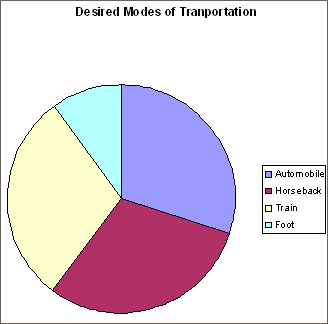
I decided to evenly distribute the steam liner, train, and horseback because each serves a necessary function. The train allows for luxury and speed when traveling long distances across the United States. The steam liner allows for Americans to move across water; however, it is limited to water travel and ports. The horse, while slow, is a proven mode of transportation that allows for the most flexibility and freedom of movement. Hence, all three deserve equal weight.
Following the completion of the Modes of Transportation chart, each student should be asked to construct an advertisement for either travel by horse or by train. Each student should select the mode of transportation he/she would prefer and create an advertisement that persuades other people to use this mode of transportation. The advertisement should be written using persuasive language, should contain images and icons, and should be colorful and attractive.
- More Advertisements: Instead of requiring students to construct one advertisement for one interest group, each student will construct four advertisements – one for each mode of transportation. Each advertisement should be written with persuasive language, should contain images and icons, and should be colorful and attractive.
- Brochure on the Transportation: Using a computer lab or paper with crayons, students will construct a museum brochure that educates people of the various modes of transportation used in the nineteenth and early twentieth centuries. Each student will construct a cover page followed by four informational panels in the brochure. On each informational panel, the students will identify the mode of transportation, its speed, its strengths as well as weaknesses, and the situation when it was most likely used. After each student has completed his/her brochure the teacher should display the brochures so student can see each others work.
- Students will be able to identify the major events of Europe in 1848 from the perspective of an American traveler.
- Students will be able to design souvenirs to represent historic sites significant in the nineteenth century as well as today.
- Students will be able to label and shade on a map the countries in Europe that make up a “grand tour”.
For this lesson, you will be relying on Eliza “Didy” Ridgely’s travel journal (Journal 34351) that she kept from 1846-1848. In addition to the travel journal, students will be expected to analyze the souvenirs the Ridgely’s acquired while in Europe which include an inkwell (40078), mirror (11681), and carving of the leaning tower of Pisa (9133). The family acquired a bronze inkwell, a neoclassic replica of the ancient Roman forum, during the trip to Rome. While visiting Pisa, they returned with an architectural carving of the leaning tower. Towards the end of the Grand Tour, the family returned with a mirror containing numerous souvenirs from the Paris Revolution of 1848. The wooden frame and fabric are both from the king’s Palais Royal.
- For this opening activity, you will need to ask each student to bring in a souvenir from a trip they took sometime during their life. The students can bring in pencils, key chains, t-shirts, snow globes, etc. The teacher may want to bring in extra items of local attractions in case students forget or are unable to participate.
- Each student will be asked to stand and hold his/her souvenir. He/She will not be allowed to speak. The class will be asked to determine:
- What is the object?
- Where did he/she go?
- What did he/she like the most?
- How long ago did he/she go?
- Once the class has taken some educated guesses about the student’s souvenir, the student will answer the above questions by telling us about his/her experience as well as why he/she acquired this item.
- The teacher may want to explain that the word "souvenir" originated in France and means to recall.
- Students should be given the Grand Tour chart. On the chart, the students will be given a description of an event as well as a souvenir the Ridgely’s acquired for each event.
- After reading about the historic event or location, the teacher should display contemporary images of the locations. For example, for the Ridgely’s trip to Pisa, the teacher will want to acquire modern images of the Baptistery, the Tower, the Duomo (church), and the cemetery.
- After examining the reading and image, each student will be asked to assess what he/she saw as the most important aspect of that journal entry.
- Then the students will be asked to examine the souvenir the Ridgely’s acquired at each location. The students will be asked to speculate on why that object was significant to the family and their experience. After the students have had time to speculate, the teacher may provide addition background information to aid in the students’ understanding of each souvenir.
- Finally, the students will be asked to design and/or construct a modern souvenir that they think the Ridgely family should have acquired at each location. Each student should explain why they designed these modern souvenirs and why they would relate to the journal entries.
- Ask the students: Based on the journal entries we just read, what do people do on a grand tour? Possible answers should include: see historic sites, visit churches, see historic objects like Galileo’s lamp, listen to lectures, witness the culture, etc.
- Ask the students: Based on the journal entries we just read, where did the Ridgely’s visit? Rome, Italy; Pisa, Italy; Paris, France. Then ask: Does visiting three European cities sound GRAND?
- Explain to the students that the Ridgely’s visited Europe for two years and traveled to many other locations. Using an Atlas and blank map of Europe, the students will identify the major European nations. The students will then shade all of the countries the Ridgely’s visited from 1846-1848.
Countries Visited on the Grand Tour |
England |
France |
Italian states (Italy) |
Ottoman Empire (Turkey) |
Greece |
Austria |
German Confederation (Germany) |
Belgium |
- After shading in the various countries, ask the students: Does visiting these countries make this a GRAND tour?
- Photo Journal of the Grand Tour: Once the students have identified the locations visited by the Ridgely family, each student will construct a photo-journal or scrapbook for the family. Each student will use the internet and locate five images of places the Ridgely’s would have seen while on their grand tour. For each image located, the student will identify the location and describe its significance in 2-3 sentences.
- Cultural Tourism: In the nineteenth century, the American elite visited seaside resorts in the United States and took Grand Tours in Europe. The class will brainstorm a list of the places “average” Americans visit today: Where do we go? Then, the class will construct a list of places that Americans desire to go but may not be able to: Where do we dream to go? Based on the dream list of places, the class will construct an itinerary including the order of the trip and number of days spent in each location. On a map of the world, the class will locate each place and draw a line mapping the planned route. For each of the locations, the class will locate two images or photographs and write a caption explaining significance or appeal. After the class has created this dream trip, they should compare it to the Ridgely’s. Then, the teacher should ask: Is our dream trip a grand tour?
- Your Own Journal: The Ridgely children kept a journal to remember the sites and people they visited while in Europe and America. Each student will construct a journal for one week of their life and write one entry per day. In the journal, the students should describe the following for each day:
- Who did you see? Who did you talk to?
- Where did you go? How did you travel there?
- What was the weather like?
- Students will be able to compare and contrast the inauguration of a president with the crowning of a king
- Students will be able to identify the social, political, and military aspects of a coronation by examining a painting.
For this lesson, you will be relying on a neo-classic painting completed, most likely, by Camillo de Vito, a Neapolitan artist. “Vista Della Gran Festa Del Re Ferdinando IV Nel Regnio Di Napoli 17 Guignion 1815” (meaning Scene Of the Great Festivity Of the King Ferdinand IV in Naples 17 June 1815)commemorates the reinstatement of King Ferdinand IV of Kingdom of Two Sicilies to the throne (Painting 1084). During the Napoleonic Period, King Ferdinand IV had been deposed by Napoleon in 1805 and Joseph Napoleon, Napoleon’s brother, had been placed on the throne until 1815. Following the final defeat of Napoleon in 1815, the major European powers, which included England, Austria, Prussia, and Russia, needed to restore the balance of power and prevent a future totalitarian leader from creating instability and war in Europe. At the meeting of the Congress of Vienna, the European monarchs restored the balance of power and reinstated numerous kings such as Ferdinand IV and Louis XVIII of France in order to re-establish a conservative ideology and prevent future wars in Europe.
- Ask students: What do you remember about the Presidential Inauguration of President Obama (or other Presidents)?
- Using the video clip “Where History Happens” by the National Park Service as well as images from “2009 Presidential Inauguration Photo Gallery”, student should be able to further describe the inauguration process. The student may use the handout “How to Read a Photography” or should consider the following questions:
- What do you see in the pictures? Be Specific.
- Who is present?
- What buildings are in the background?
- As the class describes in detail the 2009 Presidential Inauguration, each student should complete “Instating a New Leader” chart.
- Based on our observations, what conclusions can we draw about the Inaugurations:
- Was the inauguration well attended? What does this tell us about the election?
- Are there a large number of military/police? Why is there a military/police presence?
- Which flags are flying? Why?
- What building did the Presidential Inauguration occur in front of? Why?
- What type of clothing are the people wearing? What social classes attended the inauguration?
- What objects could be acquired at the inauguration as souvenirs? Why would people want to acquire them?
- Place a large copy of the Painting “Vista Della Gran Festa Del Re Ferdinando IV Nel Regnio Di Napoli 17 Guignion 1815” (Painting 1084)on a projector.
- Ask the students to assess the painting in the same way they assessed the images of the Presidential Inauguration. The student may use the handout “How to Read a Photography” or should consider the following questions:
- What do they see the picture? Be Specific.
- Who is present?
- What buildings are in the background?
- As the class describes in detail the 1815 Re-instatement, each student should complete “Instating a Leader” chart. The class should construct a list similar to the following:
Observations from Instating a Monarch in Europe in 1815 |
- Military – some on guard and some relaxed
- Kids Dancing
- Multiple Types of Clothing
- Flags
- Statues
- Religious Symbols: Cross
- Musicians
- Fountains
- Buildings – Row Homes, Government Buildings, Palaces
- Men Sitting on Horse
- Fort/Castle on the Hilltop
- Limited Grass
- Near Water
|
- In small groups, the students should debate what conclusion can be drawn using the following prompts:
- Was the reinstatement well attended? What does this tell us about the reinstatement? Why may the people of Southern Italy support the reinstatement of a king from Naples verses the previous Joseph Napoleon of France?
- Are there a large number of military/police present? What are the various activities that military/police are doing? Are they needed? Is there a threat?
- Which flags are flying? Why?
- Did the reinstatement occur in an urban or rural area? What building did the Reinstatement of Ferdinand IV occur in front of? Why? What building is the background on top of the hill? Why?
- What type of clothing are the people wearing? What social classes attended the inauguration?
- Why are there no boats in the harbor?
- Why would someone acquire a painting of this event? Did the Ridgely’s, an American slaveholding family, acquire the painting as a random souvenir or as a symbol of their conservative thinking?
- Historically speaking, why does this painting embody the principles of the Congress of Vienna?
- How does this compare to a presidential inauguration?
Once the students have reviewed all or some of the questions, the class can debrief the activity.
Based solely on the painting “Vista Della Gran Festa Del Re Ferdinando IV Nel Regnio Di Napoli 17 Guignion 1815” and the class discussion, each student should construct a first person story of the day’s event in Naples on the 15th of June 1815 (or at a presidential inauguration). The students should be required to construct a story of the entire day; therefore, the story must contain the following:
- Before: What did you do before attending the reinstatement of Ferdinand IV/Inauguration? How did you feel?
- During: What did you witness? What did you wear? Where did you stand? What could you hear? How did you feel?
- After: What was you most significant memory of the day? How do you feel?
- Live on the Scene: In this extension activity, students will construct skits as if they are a news team reporting on the scene at the reinstatement of a king. The students should be divided into groups of 5-6 people. The class will be provided with the following scenario: “Live from the Re-Instatement of Ferdinand IV. The people of the Kingdom of Two Sicilies are here to witness their king’s return to power and we’re here at Action 11 are on the scene.” Each student should play one of the following roles:
- Anchor Man: This student will be responsible for directing the news broadcast.
- First On-The Scenes Reporter: This student will be responsible for reporting the mood and describing the event.
- Second On-The Scenes Reporter: This student will be responsible for interviewing members of the crowd gathered in the square.
- Third On-The Scenes Reporter: This student will be responsible for interviewing the king before the ceremony begins.
Following the construction of the script, each group will present their skit in front of the class. This extension activity will bring the picture alive and allow the students to better relate to the event.
- Reflection Journal: The presidential inauguration and the re-instatement of a king are both significant political, national, and historical events. As a class, brainstorm national and local events that create a sense of community in your local area (for example: Fourth of July Parade, Thanksgiving 5-K, Flag Day, Strawberry Festivals, etc.). Once the students have compiled a list of ideas, each student should select an event that he/she remembers or enjoys the most. Then, each student will construct a story of the entire day; therefore, the story must contain the following:
- Before: What did you do before the event? How did you feel?
- During: What did you witness? What did you wear? Where did you stand? What could you hear? How did you feel?
- After: What was you most significant memory of the day? How did you feel?
- Students will be able to identify popular past times of the wealthy in the second half on the nineteenth century in the United States
In order to examine popular past times of the wealthy in the United States throughout the nineteenth century, students will need to analyze three photographs taken by the Ridgely family that recorded their activities. The photographs include a visit to the board walk in Atlantic City , New Jersey (44236), an excursion to beach front community in Watch Hill, Rhode Island (20394), and a seaside resort in the cooler climate of Newport, Rhode Island (16964).
- As the students walk into the classroom, the teacher should be wearing a fun hat like Mickey Mouse ears from Disney World, a floppy hat for fishing, etc. Begin class by describing a hot summer day in your hometown.
- Ask each student to draw a picture or sketch of his/her ideal vacation to escape the boredom of summer as well as the summer heat.
- After the students have completed their drawings, each student should share his/her picture and the class should construct a master list of ideas.
- Using the master list, the students will determine which activities or vacations existed in the nineteenth century? Which of the past times/vacations did not exist in the nineteenth century? Why?
- Based on the new list of nineteenth century vacations/pastimes/activities, the class will guess which form of relaxation was most likely chosen by the elite in the United States in the nineteenth Century.
- Each student should be given a placard with the three photographs of the Ridgely’s vacationing at a seaside resort. Ask the students: Did we accurately guess the means of relaxation utilized by the wealthy in the nineteenth century?
- The students should then analyze the three photographs to determine the various activities the wealthy did to entertain themselves while at the resorts. The students list should include activities like: going to the beach, visiting neighbors, looking at the beautiful views, sailing boats on the water, drinking iced tea, talking with family and friends, walking on the board walk, visiting some shops, reading a book, etc.
- Once the students have constructed a master list of activities, the class will move into small groups of 3-5 students. In the small groups, the students will be responsible for constructing an activities calendar. The activities calendar should list the time and activity for a typical day at a seaside resort. For Example:
ANSWER KEY
Sample Activity Schedule for Wealthy |
8:00 Sit on the porch to gaze at the beautiful scenery |
9:00 Go to the water to sail boats and sit on beach |
12:00 Return to cottage and sip on some Ice Tea |
1:00 A Large Meal |
3:00 Begin afternoon stroll on the board walk; Visit new shops |
6:00 Visit Neighbors at nearby Cottages |
- After constructing the activities schedule, the class should then discuss:
- What does this tell us about the wealthy in America? How did they dress on vacation? What did they do for fun?
- How do the wealthy compare to the working class? How do the wealthy compare to the middle class?
- How does this form of relaxation compare to today?
Following the examination of the photographs, each student should construct a postcard as if he/she is a wealthy citizen in the United States. The post card should be the size of a half sheet of paper. On the front side of the post card, each student should:
- Construct an appropriate illustration of life at a seaside resort.
On the back side, each student should
- Draw a stamp
- Label a false address
- Write a letter that answers: What do you do for fun at the seaside resort? What are the various activities you engage in? In your own opinion, would you like to be a wealthy American in the 19th century? The letter should be a minimum of four sentences.
- What Would You Do for Fun?: At the beginning of this lesson, each student identified and drew his/her ideal vacation. Now, allow each student to construct his/her own activity schedule for one day on that ideal vacation. The students may need access to the internet or travel books in order to complete this activity. By the end of the class period, each student will have constructed his/her own itinerary. The teacher should ask the class:
- How did your day compare to the Ridgely’s?
- Which day seemed more relaxing?
- Letter/Postcard: Continuing from the Extension Activity #1: What Would You Do for Fun?, each student will make a postcard based on his/her ideal vacation. The post card should be the size of a half sheet of paper. On the front side of the post card, each student should:
- Construct an appropriate illustration of his/her ideal vacation
On the back side, each student should
- Draw a stamp
- Label a false address
- Write a letter that answers: What did you do for fun on your ideal vacation? What are the various activities you engage in? In your own opinion, would wealthy Americans living in the 19th century enjoy your ideal vacation? The letter should be a minimum of four sentences.
- Students will be able to demonstrate their knowledge of nineteenth century travel by constructing a Travel Trunk
In order to complete the final project, the students will first need to analyze a real travel trunk from the nineteenth century. The travel trunk located in this photograph was utilized by the Ridgely family throughout the nineteenth century. The trunk is decorated with paper stickers from European countries, cities and hotels. The leather hat box in the picture has an inscription on it – “C. Ridgely of H.”
- Place a large piece of luggage in the front of the classroom. Preferably attached to the luggage would be numerous airline luggage tags, destination stickers, etc. The luggage tags/stickers should be from numerous airlines as well as contain numerous destinations.
- On the chalkboard or overhead, construct three lists that the class will complete as a group. The three lists are as follows:
Where did the Luggage travel to? |
How did the luggage travel? |
What is the condition of the luggage? |
|
|
|
- Each student will be called up individually and asked to assess the luggage and add one statement to one of the lists on the chalkboard.
- After completing the inspection of the luggage, the class should be able to determine: Where someone traveled? How someone traveled? What the travel experience was like?
- Display the photograph of the Ridgely’s travel trunk and hat box on a large projection screen.
- Like before, the class will be asked to assess this historic luggage by completing the same chart. Each student will be asked to contribute one statement to be placed on the class list.
Where did the Luggage travel to? |
How did the luggage travel? |
What is the condition of the luggage? |
|
|
|
The teacher may use prompts to help the students complete the analysis of this historic trunk.
- What is on the trunk?
- Where did the trunk travel to?
- What various modes of transportation were most likely used to travel to these locations?
- What is on the hat box?
- What is the condition of the items?
- After completing the chart, the class should be able to determine the various locations the Ridgely family traveled? How they traveled? What the travel experience was like?
- The class will be placed into groups of 4-5 students. Each group should be given a cardboard box and lid (for example: use the paper boxes found in copy rooms or a shoe box). The box and lid should be wrapped with a solid paper. Each box represents a trunk. Each group is responsible for creating their own travel trunk.
- On the outside of the travel trunk, each group must:
- Identify their names on the box
- Create six labels; one for each country visited on a grand tour of Europe
- Create one label for a U.S. seaside resort
- Create two transfer stamps to represent two modes of transportation
- The box should be damaged according to the group’s desire. It is recommended that the group be required to place a stain on the box. For example, mud, dirt, water spots, etc.
- On the inside of the travel trunk, each group must:
- Place six objects in the trunk. The objects can be contemporary items or the student may construct facsimiles out of cardboard, clay or construction paper.
- Each object should be tagged and on the tag should include a description of the item, the location in which the items was acquired, and why it has significance to the group and the travel trunk.
- Following the completion of the group’s trunk, each group will present their travel trunk to the class. During the presentation, the group will note the modes of transportation used, the experiences witnessed by the trunk, and various locations visited. By the end of this activity, the class will have a complete understanding of travel in the nineteenth century for America’s wealthy.
- Time Capsule: In this activity, students will be organized into small groups of 3-4 people in order to construct a time capsule that exemplifies the travel experiences of elite Americans in the 19th century. The groups will need to select ten objects to place in the time capsule and each object should demonstrate or symbolize an attribute of American travel in the 19th century. Once each group has determined their ten objects, the group will write a letter that will be placed in their capsule. In the letter, each group should:
- Explain the purpose of this time capsule
- Explain the significance of each object
Once the students have completed their time capsules and letters, each group should present their objects to the class. As the group removes an object, the class will guess its significance. By the end of the presentations, the class should have a better understanding of 19th century travel.
|
- See individual Lessons
- For a cumulative assessment, see Lesson #6
[Back to top]
|
|
|
|
[Back to top]
|
Hampton Mansion – National Historic Site, Towson, Maryland
[Back to top] |
|

